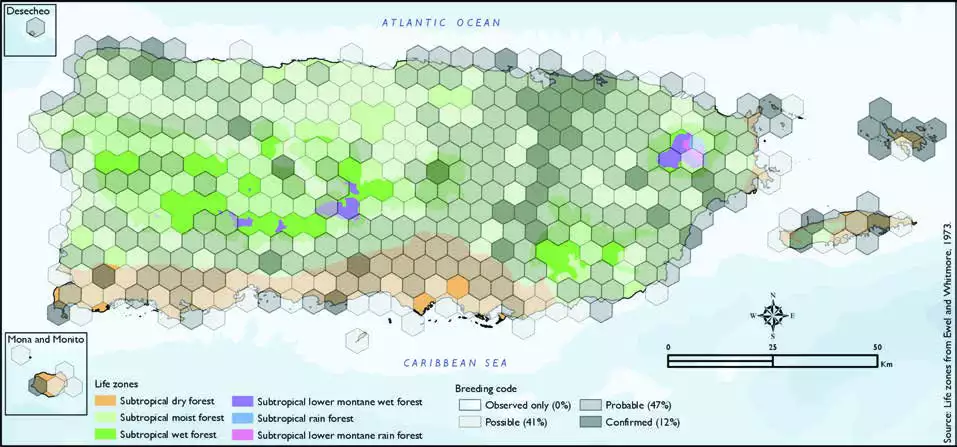Zenaida Dove
Description
The zenaida dove (Zenaida aurita) is a member of the bird family Columbidae, which includes doves and pigeons. It is the national bird of Anguilla, where it is locally referred to as "turtle dove".
The Zenaida dove is approximately 28–30 cm (11–12 in) in length. It looks very similar to the mourning dove, but is smaller in size, has a shorter, more rounded tail, and is a bit more darkly colored. It is also distinguished from the mourning dove by showing white on the trailing edge of its wings while in flight. The mourning dove does not have the white trailing edge.
Distribution & Habitat
The Zenaida Dove occurs on the south coast of Florida, the
coast of the Yucatán Peninsula,
and throughout the West Indies,
where it is a common year-
round resident (Raffaele and
others 1998). It is fairly abundant
throughout Puerto Rico and can be seen from cultivated fields
in the lowlands all the way up
to the mountains (Biaggi 1997,
Rivera-Milán 1996). It also occurs
in Mona (Barnés 1946, Gordon
and others 1961, Oberle 2018,
Terborgh and Faaborg 1973),
Desecheo (Meier and others
1989), Culebra (Oberle 2018,
Wetmore 1917), and Vieques
(Sorrié 1975, USFWS 1994),
in the latter being a common
resident throughout the year
(Gemmill 2015). It is found
throughout the archipelago
including mangrove cays and
other small cays with scarce
vegetation. This species primarily
inhabits open coastal areas, hotel
grounds, and gardens but also
scrub thickets, open woodlands, pine woods (Raffaele and others
1998), farms, towns (Oberle
2018), coffee plantations (Biaggi
1997), and mangroves (Biaggi
1997, Oberle 2018, Sorrié 1975).
The atlas fieldwork yielded a
total of 938 records within 406
hexagons or 85 percent of the
479 total hexagons (see map).
Of the 406 hexagons where this
species was found, breeding
met the atlas definition of
confirmed in 12 percent (48)
of the hexagons, probable in
47 percent (192), and possible
in 41 percent (165), while this
species was also observed in an
additional hexagon (<1 percent)
but without evidence of breeding
(see map). Zenaida Dove distribution. The map shows the highest breeding code by hexagon and overlaying the ecological life zones in
Puerto Rico. Note: percentages may not total 100 due to rounding. 63Zenaida Dove/Tórtola Cardosantera

Breeding Habits
The Zenaida Dove generally builds a thin platform nest
made of twigs, usually in a
tree or bush, but sometimes
on the ground (Raffaele and
others 1998, Wiley 1991) or in a
cactus, palm (Oberle 2018), and
even mangroves (Sorrié 1975).
Previously published reports
indicate that breeding is variable
as it occurs throughout the year
in urban areas, from February to
June in moist and wet habitats,
and from April to June in dry or
arid zones (Raffaele and others
1998). Atlas results show that this
species breeding season extends
throughout the year with the most breeding activity from
March to June (see chart). The
breeding activity peaks during
May and June, and mostly takes
place within the subtropical
moist forest life zone (see chart).
Results show that this species
breeds throughout the island but
mostly within the subtropical
moist forest life zone (61 percent
of the hexagons) (see table), but
it also breeds in the subtropical
dry forest life zone (23 percent
of the hexagons) and within
subtropical wet forest life zones
at higher elevations (15 percent
of the hexagons) (see table
and map).
Conservation
The current population trend of the Zenaida Dove is suspected
to be increasing in some parts
of the West Indies (del Hoyo
and others 2013). This species
is currently listed as a species
of least concern by the IUCN
(BirdLife International 2016).
Locally, this species is not
listed in any of the threatened
categories of PRDNER and
USFWS. In Puerto Rico, the
Zenaida Dove has a protected
habitat in land of 12 percent
or 1192 km2 of the total area covered by the hexagons where
evidence of breeding was found
for this species (9685 km2).
Related Species
Family:
dove